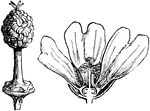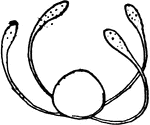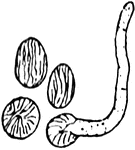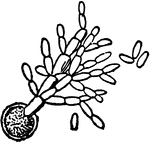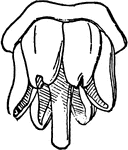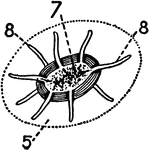Clipart tagged: ‘spore’
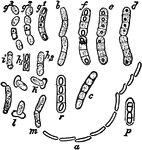
Bacillus Megaterium
"a, a chain of motile rodlets still growing and dividing (bacilli). b, a pair of bacilli actively growing…

Bacillus Megaterium
"Successive stages in the development of the spores." — The Encyclopedia Britannica, 1910
Bacillus Megaterium
"A rodlet segmented in four, each segment containing one ripe spore." — The Encyclopedia Britannica,…
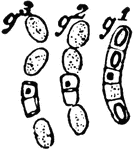
Bacillus Megaterium
"Early stages in the germination of the spores (after being dried several days)." — The Encyclopedia…

Bacillus Megaterium
"Successive stages in the germination of the spore." — The Encyclopedia Britannica, 1910
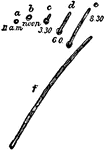
Bacillus Ramosus
"The various phases of germination of spores of Bacillus ramosus, as actually observed in hanging drops…
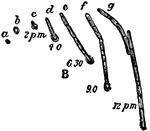
Bacillus Ramosus
"The various phases of germination of spores of Bacillus ramosus, as actually observed in hanging drops…
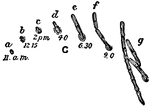
Bacillus Ramosus
"The various phases of germination of spores of Bacillus ramosus, as actually observed in hanging drops…

Bacillus Ramosus
"The various phases of germination of spores of Bacillus ramosus, as actually observed in hanging drops…
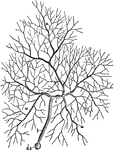
Brown Mold
An example of brown mold (mucor mucedo). s, spore; m, mycelium; t, gonidiophore; sp, sporangium.

Clostridium
"Germination of spore of Clostridium butyricum—the axis of growth coincides with the long axis…
Cocci
"A chair of cocci of Leuconostoc mesenterioides, with two "resting spores," i.e. anthrospores." —…

Curlygrass Fern
Schizaea pusilla, or Little Curlygrass Fern is a small species of fern in the Curlygrass family (Schizaeaceae).…
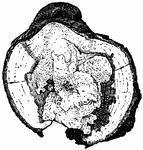
Fomes Igniarius Infected Maple Limb
Pictured is the cross section of a maple limb affected by Fomes igniarius. A young spore is shown as…

Heterospory
"In the lower plants the numerous asexual spores which each individual produces are usually alike. Among…

Wood Horsetail
"Equisetum sylvaticum: a, a, sheath crowned with teeth; b, branches; c, c, fruiting spikes. 2. Clypeola,…

Laminaria Saccharina
Laminaria saccharina belongs to the group Laminariæ, a group of algæ belonging to the Phæosporeæ,…

Powdery Mildew Ascus Containing Eight Ascospores
An illustration of powdery mildew showing the ascus containig eight ascospores.

Powdery Mildew Conidia Bearing Hypha
An illustration of powdery mildew showing conidia bearing hypha.

Powdery Mildew Sporocarp & Mycelium
An illustration of the sporocarp and mycelium of powdery mildew.
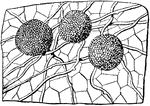
Powdery Mildew
An illustration of erysiphe communis, powdery mildew, that is on the epidermis of the leaf of the flower,…

Prothallus (under side)
The flat, heart shaped body which results from the development of a spore of a fern.
Rodlet
"A motile rodlet with one cilium and with a spore formed inside." — The Encyclopedia Britannica,…
Stem Rust
Also known as Puccinia graminis. This fungus is a significant detriment to cereal crops. It is currently…
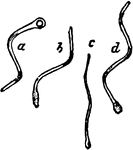
Schizomycetes
"Spore-formation in Vibrio-like (c) and Spirillum-like (a, b, d) Schizomycetes." — The Encyclopedia…

Spirillum
"Spirillum containing many spores (a), which are liberated at b by the breaking up of the parent cells."…
Spore
"Long rod-like form containing a spore (these are the so-called "Kopfchenbacterien" of German authors)."…
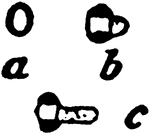
Spore
"Germination of the spore of the hay bacillus—the axis of growth of the germinal rodlet is at…
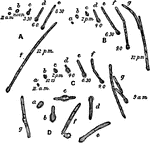
Sporegerm
"The various phases of germination of spore of Bacillus ramosus, as actually observed in hanging…
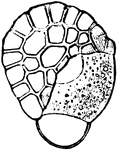
Germinating Spore of the Common Polypody
An illustration of a germinating spore of the common polypody: sp, exospore; k, first root-hair.

Germinating Spore of the Common Polypody
An illustration of a germinating spore of the common polypody: sp, exospore; k, first root-hair.

Spores
"Various stages in the development of the endogenous spores in a Clostridium — the small letters…
